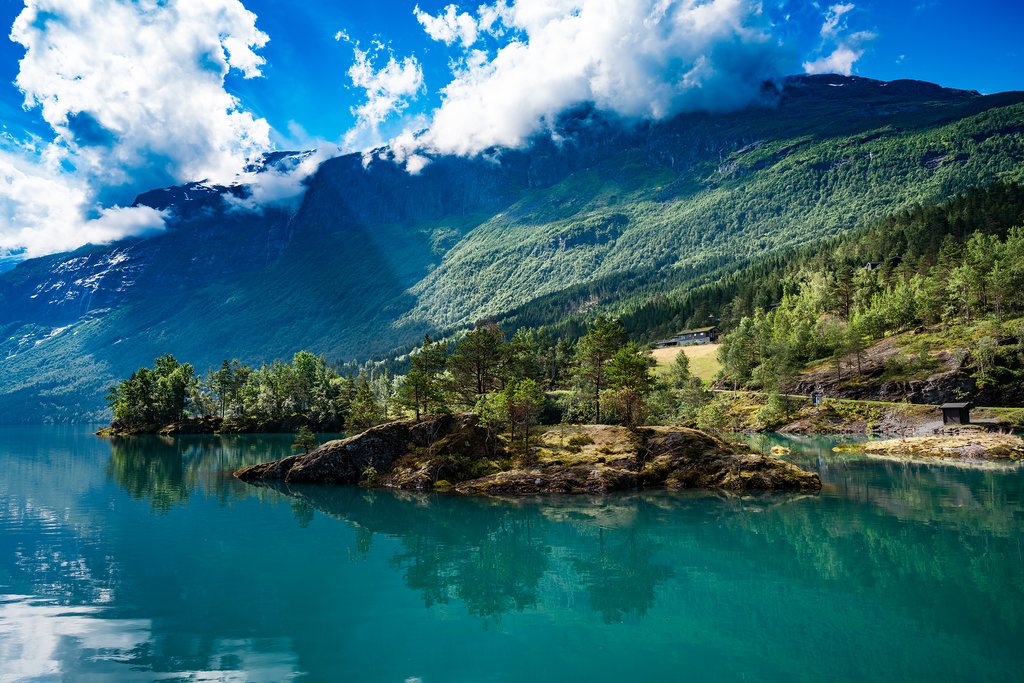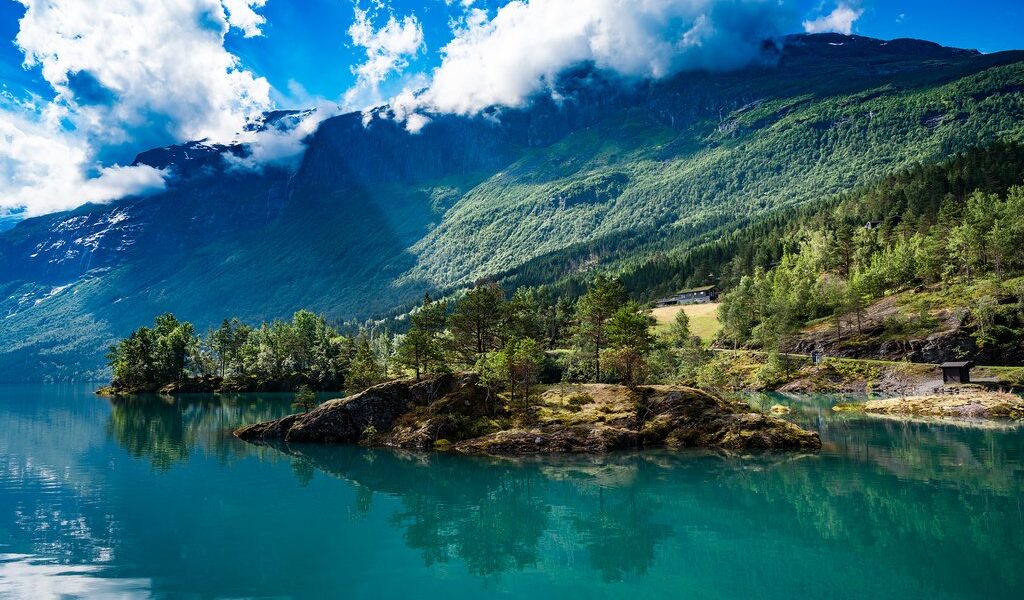
Despite its northerly location, Norway is an amazing destination any time of year. Summer months bring the endless daylight of the Midnight Sun as well as warmer temperatures, making June-August the busiest season. However, winter time (October to March) is equally stunning, offering the opportunity to view the northern lights. And for those looking to avoid other tourists, spring and fall are by far the quietest months with a more temperate climate.
Seasonal Planning for Norway Travel
It might seem like an overused phrase, perhaps even hard to believe, but Norway truly stands out as a remarkable destination that welcomes visitors throughout the entire year. Of course, certain months might be more appealing to some travelers than others – perhaps someone from Florida might not be thrilled about visiting during the snowy depths of January. However, rest assured that each and every season in this stunning country offers a unique range of activities and attractions, perfectly suited to the time of year. This makes Norway an ideal destination no matter when you choose to travel. Planning a trip to a new country can be daunting, but knowing there are amazing opportunities year-round makes Norway an ideal choice.
When embarking on the planning process for a trip to Norway, many people find themselves particularly drawn to the prospect of witnessing either the breathtaking fjords or the mesmerizing northern lights, or perhaps even both. While the majestic fjords can be admired throughout the year, it’s crucial to remember that the summer months, despite being a popular and often crowded time, generally offer the widest array of options when it comes to both activities and accommodations. This is because some hotels and local tour operators may have seasonal closures during the less busy periods. For those whose primary goal is to witness the enchanting dance of the northern lights, the window of opportunity is somewhat more limited, as the aurora borealis is typically only visible from October through March.
Regardless of the specific time of year you decide to visit, Norway is undeniably a haven for adventure enthusiasts. The key to a successful and enjoyable trip lies in being well-prepared for potential changes in weather and temperature. Embracing a relaxed and adaptable attitude, much like the locals do, will undoubtedly contribute to an unforgettable Nordic journey that exceeds all expectations.
Spring in Norway (March to May)
In Norway, the arrival of spring tends to be quite sudden and often unpredictable. As the temperature begins to gradually rise, the snow and ice that blanket the majestic mountains begin to thaw, giving rise to a stunning abundance of natural waterfalls and the delicate emergence of wildflowers. In fact, during this particular time of year, the blossoming countryside bears a striking resemblance to a scene straight out of the beloved musical, “The Sound of Music.” The transformation is remarkable, with the landscape bursting into life after the long winter months.
It’s important to exercise caution and be aware that if you are meticulously planning your trip to coincide with these specific natural occurrences, they have been known to commence as early as February or as late as May. It is also wise to be prepared for rapid and unexpected shifts in weather conditions, as spring in Norway can often bring sunny and bright mornings followed by rainy afternoons, all within the span of a single day. With that being said, this time of year is arguably the most picturesque, offering a visual feast of colors and textures. Furthermore, you’re less likely to encounter large crowds of fellow travelers, making it an ideal time to visit popular sites like Trolltunga and Pulpit Rock without the usual throng of visitors.
Summer in Norway (June to August)
Given the more temperate and pleasant weather conditions, it comes as no surprise that the vast majority of visitors choose to flock to this Nordic paradise during the summer months. In the southern regions of Norway, such as Oslo and the breathtaking Bergen/fjord area, temperatures typically hover in the low 70s (Fahrenheit) during the daytime, gently dropping to the mid-50s during the evening hours. Daylight stretches for an incredible 20-plus hours per day, providing ample time to explore and soak in the stunning surroundings. The once-frozen fjords and snow-covered roads are now fully accessible, allowing visitors to traverse the country with ease, whether by car, bus, train, plane, or boat.
However, it’s crucial for travelers to be aware that accommodations throughout the country tend to book up well in advance, often months ahead of time. Therefore, it is highly recommended to engage in meticulous advance planning to secure your desired lodgings. For those seeking to escape the bustling crowds, summer presents an ideal opportunity to venture inland or toward smaller, charming coastal towns that are not accessible by large cruise ships overflowing with eager tourists. Summer is also the perfect season to embark on an adventure to Svalbard if you have ever harbored a dream of spotting magnificent polar bears in their natural habitat.
Consider embarking on a memorable 12-day summer road trip, making stops in the vibrant cities of Oslo, Bergen, and Trondheim. Alternatively, venture north toward Lapland, taking advantage of the countless summertime activities and experiences that the region has to offer.
Fall in Norway (September to November)
Although autumn in Norway tends to be colder and wetter in comparison to the summer months, there are some distinct advantages to planning your travels during this captivating season. As any seasoned photographer will attest, the fall color palette is an absolute must-see, boasting a breathtaking array of stunning golds and vibrant reds. The landscapes transform into a canvas of warm hues, creating a truly unforgettable visual spectacle. Taking a hike in the autumn is highly recommended.
For those who find the intense summer sun to be overwhelming, fall offers a welcome respite with its crisp, cool air (especially during the early months). It also provides a chance to indulge in the delicious local berries that are in season. While the end of fall can bring some unpredictable and even wild weather conditions, it also presents a fantastic opportunity to explore the local cafés and restaurants, where you’ll find most Norwegians seeking shelter from the storms alongside you. These cozy establishments offer a warm and inviting atmosphere, perfect for enjoying a hot beverage and engaging in conversation. For those interested in exploring Northern Norway during this season, there is a wealth of unique and exciting activities to discover.
Winter in Norway (December to February)
If you don’t mind a bit of snow and ice, Norway transforms into a veritable winter wonderland during the months of December to February. Surprisingly, the weather doesn’t get as frigid as one might expect, with temperatures typically not falling far below the freezing point. As the Norwegians themselves wisely say, “There is no bad weather, just bad clothing.” Embracing the right attire will allow you to fully enjoy the winter landscape.
The biggest draw during this time of year is undoubtedly the Northern region, which offers an almost guaranteed opportunity to witness the mystical and awe-inspiring northern lights. Lapland is also renowned for its captivating outdoor excursions, which range from exhilarating dog sledding adventures to skiing (the national sport), snowmobiling, and even enchanting reindeer safaris. However, don’t anticipate a leisurely self-drive trip. Due to the snowy conditions, the easiest and most efficient means of getting around this time of year involves short flights and 4WD or super jeep transfers. These modes of transportation will ensure that you can navigate the winter landscape safely and comfortably. The Lapland region in winter offers a wide array of incredible experiences that are not to be missed.
B-1988

